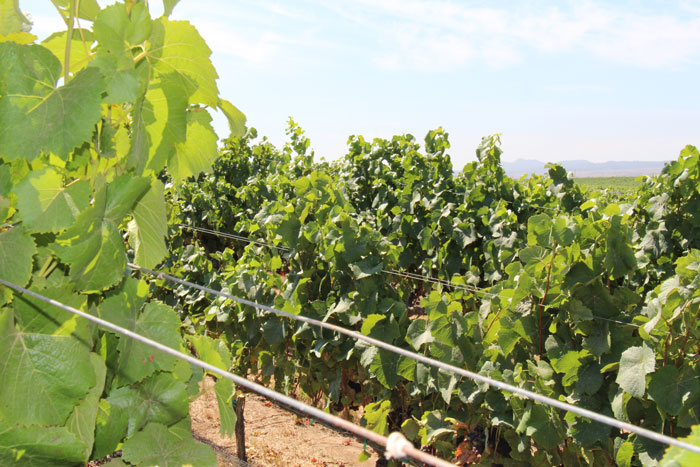
Viticulturist fingers poor conditions during bloom for last year’s disappointing Central Coast yields
“Last year, many growers kind of knew after bloom that the crop would be a poor one, but they just didn’t believe it would be that poor. I doubt I’ve seen this same situation more than once before, if then.”

The experiences of growers last year in the Central Coast region of California highlight some of the perils that can befall a wine grape crop at bloom.
Few growers here made it through the 2015 season without suffering significant yield losses, notes viticulturist Dr. Lowell Zelinski, owner of Precision Ag Consulting, Paso Robles, Calif. He’s worked as a consultant with wine grape growers in the Central Coast for more than a decade.
“It was a bad year for almost every Central Coast grower,” Zelinski says. “Most yields were off by 50 percent or more. The type of variety didn’t seem to matter. Many blocks that usually produce 20 tons of grapes per acre gave only 2 tons. I know of one block that was written off by the insurance company as a total loss before harvest. Of the 40 or so harvests I was involved with, every one of them was depressing.”
Zelinski, a former University of California Cooperative Extension farm advisor, listed a number of possible causes for the abnormally small crop here in 2015 – an accumulation of salt in the root zone after four years of little rain; poor flowering conditions in 2014 that damaged the primary buds that gave rise to the 2015 crop; trunk and cordon diseases; bunch rot following 3 inches of rain in July, hail in mid-June and, possibly the wrong trellis system.
“These factors may have played a role in some cases, but I doubt they were the primary reasons for such large yield reductions,” Zelinski says. “If so, there would have been some good yields out there, somewhere, but there weren’t.”
So what happened? He suspects quite a few flowers in the vineyards never reached the point of being able to be fertilized, and he has some ideas about why that happened.
“Last year, many growers kind of knew after bloom that the crop would be a poor one, but they just didn’t believe it would be that poor,” Zelinski says. “I doubt I’ve seen this same situation more than once before, if then.”
Zelinski pins most of the blame for last year’s small Central Coast crop on cold temperatures during a prolonged bloom in May that stunted growth of pollen tubes, reducing fertilization. Also, the cool weather prevented flowers from opening properly.
Last year, Central Coast vineyards began to flower, as they typically do, in late April and early May. However, temperatures remained unusually cool until the last week of May. In fact, the average temperature in 2015 for the entire month of May was the same as for March, Zelinski notes.
A grape ovule can produce as many as four seeds. The more seeds, the bigger the berry and the higher the yield. Perhaps the cold temperatures reduced viability of some of those seeds or, maybe, the pollen wasn’t very viable. “Last year, many berries had only one pollinated seed,” he says. “That contributed to the low yields.”
Last year’s lengthy flower bloom didn’t help matters. Individual grape flowers and pollen are only receptive for about two days, before becoming infertile. Normally, the process in a given vineyard is over and done within two weeks or less. Not so in 2015.
“The bloom lasted every bit of a whole month,” Zelinski says. “So even if there were favorable days for pollination and fertilization to occur, it wasn’t favorable to very many berries per cluster.”
However, Zelinski attributes much of the impact of last year’s cold bloom temperatures on limiting growth of the pollen tubes. These tubes allow the male gamete or sperm in the pollen deposited on the flower stigma to reach the base of the flower and fertilize the eggs.
Fueled only by energy from pollen grains, a pollen tube can grow to its full length of about 1/4 to 3/8 inch in length in two or three days with temperatures of about 80 degrees or warmer, Zelinski notes.
But under the cold conditions of last year’s bloom a pollen tube may require seven to 10 days to grow to its full length. That’s too long for the supply of energy in the pollen grains to sustain the pollen tubes, he says. As a result, the pollen tubes ran out of steam last year and died before reaching the base of the flower.
“It’s a hypothesis,” he says. “But I found examples in the scientific literature that this can happen.”
Adding to the problems during last year’s bloom was the failure of flower caps to fall off and allow the flowers to open properly. The flower cap, called the calyptra, is composed of five petals that fuse together to form the flower. In most plants, flowers open from the top down. However, the grape flower begins opening at the base as an abscission layer between the individual petals grows.
If the abscission layer fails to develop properly, as in 2015, the petals don’t separate fully and the cap remains stuck at the top of the flower, Zelinski explains. This prevents the anthers, which contain sacks of pollen, from extending above the stigma. Unable to dry properly, the pollen sacks fail to release the pollen as they should.
“The result is greatly reduced pollination and, thus, fertilization,” Zelinski says. “And that’s another reason for the poor fruit set in 2015.”
About the Author(s)
You May Also Like



